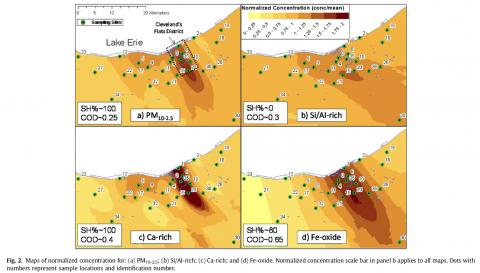Passive samplers deployed at 25 sites for three, week-long intervals were used to characterize spatial variability in the mass and composition of coarse particulate matter (PM10-2.5) in Cleveland, OH in summer 2008. The size and composition of individual particles determined using computer-controlled scanning electron microscopy with energy-dispersive X-ray spectroscopy (CCSEM-EDS) was then used to estimate PM10-2.5 concentrations (μg m−3) and its components in 13 particle classes. The highest PM10-2.5 mean mass concentrations were observed at three central industrial sites (35 μg m−3, 43 μg m−3, and 48 μg m−3), whereas substantially lower mean concentrations were observed to the west and east of this area at suburban background sites (13 μg m−3 and 15 μg m−3). PM10-2.5 mass and components associated with steel and cement production (Fe-oxide and Ca-rich) exhibited substantial heterogeneity with elevated concentrations observed in the river valley, stretching from Lake Erie south through the central industrial area and in the case of Fe-oxide to a suburban valley site. Other components (e.g., Si/Al-rich typical of crustal material) were considerably less heterogeneous. This work shows that some species of coarse particles are considerably more spatially heterogeneous than others in an urban area with a strong industrial core. It also demonstrates that passive sampling coupled with analysis by CCSEM-EDS is a useful tool to assess the spatial variability of particulate pollutants by composition.
